 |
 |





 |
 |
 |
 |
 |
 |
Partnership plants trees, shrubs to create living snow fence
|
 |
 |
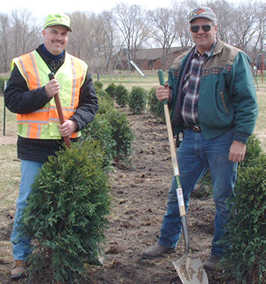 |
(l-r) Dan Gullickson,
a forester with Environmental Services, and Herb Nelson, maintenance supervisor
at Morris, led a group of students in Herman in planting nearly 500 trees
and shrubs to create a living snow fence along the school’s frontage on
Hwy 27. Photo by Pamela McLeod
|
In cooperation with Mn/DOT, students at the Herman-Norcross Community School
in Herman planted nearly 500 trees and shrubs to create a living snow fence
along the school’s frontage on Hwy 27. The planting occurred April 26, the 130th
anniversary of Arbor Day.
Dan Gullickson, a forester with Environmental Services, and Herb Nelson, maintenance
supervisor at Morris, led the project.
Mn/DOT and the school entered into the community landscaping partnership to
keep snow from drifting onto the adjacent sidewalk, which often forces students
to walk in the roadway.
"We are trying to contain the snow on the football field and trap it there
before it gets to the highway, the playground and the parking lot as well as
protect the homes downwind," Gullickson said.
Mn/DOT provided 492 trees and shrubs; students at the school did the planting.
Students planted trees such as silver maples, common hackberry and Ponderosa
pine and shrubs including gray dogwood, cardinal red osier dogwood and wayfaring
viburnum.
The snow fence will beautify the community, increase safety and help reduce
highway maintenance costs, Gullickson said.
By Pamela McLeod, Detroit Lakes District public affairs coordinator
|
back

|
 |
Land Management distributes several functions to districts, begins work on transition
plan
|
 |
 |
The Office of Land Management began work on transition plans as soon as the
Senior Management Team decided April 29 to distribute—in whole or in part—nine
functional areas to the districts and Metro Division.
The next day, Al Pint, director of the Office of Land Management, gathered
office employees together to present the decisions and to address the concerns
of all Land Management employees—regardless of whether their job tasks will
migrate to the districts and Metro Division or remain centralized.
"These changes can’t happen overnight," he said, "but the transition team will
work as quickly as possible so that affected staff will not be left in limbo."
Besides discussing the decisions, Pint addressed some of the emotional concerns
expressed by employees.
"I encourage you to talk with me; my door is always open," he said. "If you
have questions and concerns you would like answered, send me a note or set up
a time to meet with me, and I will do my best to have answers for you."
Functions being partially or totally distributed are:
-
Preparation of appraisals
-
Right of way plats
-
Preparation of condemnation maps
-
Acquisition services (office abstracts and other right of way legal documents
-
Preparation, review, and storage of legal descriptions
-
Direct purchase document preparation
-
Right of way acquisition offers and negotiation
-
Computation of replacement housing and rental entitlements
-
Demolition contracts and hazardous materials
Functions remaining centralized are:
-
Geodetic 1st and 2nd order control data, HARN system, and database
-
Photogrammetric aerial photo collection and map production
-
Project coordination (i.e., Project certification)
-
Data base maintenance and development (i.e., ROWIS)
-
Appraisal reviews
-
Appraisal contract administration (with pilots in District 3 and Metro)
-
Preparation, updating and storage of final right of way maps
-
Title services
-
Preparation, review, and storage of Commissioner’s Orders
-
Approval/payment of relocation claims
-
Survey research and support
"We care about our employees," Dick Stehr told about 125 employees attending
a "Discussions With Dick" meeting April 30. "That’s the reason I’m here talking
to you every couple of weeks. We’re asking people to make dramatic changes.
These are very stressful times. We want to help you through that." Stehr, acting
Program Support Group director, is leading the change management effort of Shaping
Our Future.
Pint also announced that working groups would be established to develop a transition
plan for functions that will migrate to the districts and Metro Division.
"The working groups will report back to me with their transition plan by June
20, 2002," he said. "We expect that fully implementing the plan could take up
to eighteen months, depending on training and pilot program needs."
Pint emphasized that he did not want to lose any employee whose tasks are redistributed,
and said that training and individual help will be offered to these employees
to help them find other positions within Mn/DOT.
Stehr reinforced this message for attendees at his Discussions With Dick session,
saying that training, skill assessment and other Human Resources services would
be available to help employees whose jobs are transitioning to other areas.
"I expect very few, if any, people will lose their jobs in Mn/DOT," Stehr said.
"There are so many needs for people in this department that we are going to
do our best to hold on to people and give training to anyone whose job is affected.
We’re going to work very hard to help her or him find a new role in the organization.
"With many retirements coming up, we’re going to see turnover, and in that
turnover is opportunity for people to do something different," he added. "I
encourage people to start looking for opportunities. Look at your skill base.
Look at what the needs are in the department. I think there is opportunity here."
In addition, Land Management will explore the disposition of the sale/lease/rental
unit administration of buildings and properties.
An additional information resource for employees is the Shaping Our Future
Web site, which includes decisions, reasons
and timelines and much more.
|
back

|
 |
Dwindling workforce and dwindling resources: How Mn/DOT plans to fill the gap
|
 |
 |
Mn/DOT has the potential to lose 65 percent of its engineering and technical
workforce in the next five years due to retirements and attrition, according
to Mark Carlson, Human Resources director.
The state hiring freeze and budget shortfall have put some restrictions on
how many people Mn/DOT can hire internally or on contract. Even before the freeze,
it was becoming increasingly difficult to hire qualified professional and technical
employees.
And the situation is not likely to get better in the future.
"Shaping Our Future changes to increase efficiencies around the agency
are helping Mn/DOT work better with the current staff," Carlson said, "but
we still have to deliver a larger-than-normal transportation program.
"Exceptions to the hiring freeze for positions providing essential government
services addressing safety, emergencies and program delivery may not be enough
to continue to deliver transportation services on time, within budget and aligned
with customer needs."
"Mn/DOT has been increasing recruitment efforts for the last three years,
but more has to be done," Carlson added.
But does "more" mean hiring more consultants, which is what other
states such as Indiana, New Jersey and Illinois have done?
"This is not a trend Mn/DOT wants to follow," said Deputy Commissioner
Doug Weiszhaar. "We want to maintain the capability to deliver a program
in-house. We also must have trained internal staff to evaluate the work of consultants
to be sure they are providing quality service at a fair price."
According to Dick Stehr, Shaping Our Future change management leader and acting
Program Support Group director: "We are working to determine what we can
deliver in-house with the professional/technical staff we have. What we can’t
do in-house, we will have to contract out."
Carlson added, "The Office of Human Resources staff is committed to improving
recruitment efforts in order to reduce the need to hire consultants. We are
looking at new and better ways to expand our pool of qualified candidates."
Human Resources’ expanded recruitment and retention efforts include:
-
TRAC and Explorer programs to interest people at a younger age in careers
with Mn/DOT
-
Education programs to support or supplement those that many colleges and
technical schools are reducing or discontinuing
-
Expanded efforts to create a more diverse candidate pool
-
A coordinated, department-wide training program to prepare employees to
do different jobs and improve skills for the jobs they already have
-
Strategic staffing to help get the right people, with the right skills,
in the right place at the right time
-
A mentoring program that helps employees increase their department knowledge
and prepare for career development opportunities
-
A professional and supervisor rotation program that allows supervisors
to learn new management and employee relations skills from their peers
-
A new Organizational Health Unit that offers health and wellness services
to help improve the well-being and productivity of Mn/DOT's workforce
-
An active recognition program to reward employees for the good work they
do
"A skilled, productive workforce is needed right here, now and in the
future, so we can continue to meet customer needs and Move Minnesota,"
Weiszhaar concluded.
For more information about the Office of Human Resources services and initiatives,
visit the Web page at http://www2.hr.dot.state.mn.us/hrw3/
or contact Mark Carlson at 651/284-4025.
By Donna Lindberg
|
back

|
 |
Two corridor improvement projects combined in Rochester to save time, money
|
 |
 |
Mn/DOT, Olmsted County and the city of Rochester announced May 1 that the County
Road 14 – 75th Street NW interchange project has been combined with the design-build,
best-value project to reconstruct Hwy 52 from Hwy 63 to 65th Street NW in Rochester.
Because the Co. Rd. 14 – 75th St. NW project was adjacent to the Hwy 52 design-build
project, it was logical to consider packaging both projects into one. Combining
the two high-priority, interregional corridor improvements also has several
advantages, according to Commissioner Elwyn Tinklenberg.
"Packaging these two projects makes sense. It provides better coordination
and helps accelerate the letting of the interchange project at Co. Rd. 14 and
75th St. NW. This gives our local partners, Mn/DOT and the design-build contractor
a better opportunity to achieve the best value in terms of cost, staging and
timing," he said.
The Hwy 52 design-build, best-value project is Mn/DOT’s largest, one-time,
highway construction project. Using the design-build process to complete the
project in five years or less instead of the original 11-year time frame is
expected to save an estimated $30 million in inflationary costs. And because
Rochester—and the price of real estate—continues to grow, Mn/DOT, Olmsted County
and the city of Rochester are expected to save millions more by avoiding future
right of way acquisitions.
Click here to read the complete
news release.
By Brian Jergenson, Rochester District public affairs coordinator
|
back

|
 |
Short parking lot detour goes long way to lessen highway work’s impact on Clara
City
|
 |
 |
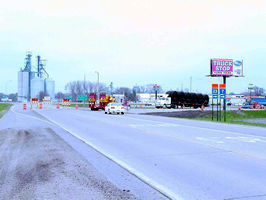 |
Trucks and other traffic
make a short jog through a truck stop parking lot in Clara City on a detour
route that keeps access to the truck stop and other businesses open during
reconstruction of the Hwy 7/Hwy 23 intersection. Photo by Darrell Terlisner
|
Create a short, sensible detour—even across a truck stop’s parking lot—and
they will use it. Especially if "they" (truckers and other drivers,
that is) probably would have gone that way anyway.
Building on good working relationships with Chippewa County and Clara City
officials and business owners, Willmar District project managers placed a detour
route 300 feet long across Donner’s Crossroads parking lot to carry traffic
around work on the Hwy 23/Hwy 7 junction.
The $1.4 million project will realign the intersection and resurface the roadway.
The owner of the busy truck stop expressed concern that a detour on other trunk
highways would have steered trucks and other traffic away from his business
and others in town. The truck stop occupies the interchange’s southeastern corner.
Hence, a solution emerged. The district acquired a right-of-way easement from
owner Tony Donner after he suggested using his parking lot as part of the detour.
Detoured traffic skirts his buildings and then uses Chippewa County Road 2,
a city street and a township road to make the connection between Hwy 7 and Hwy
23.
Jeff Vlaminck, regional engineer at Willmar, said the easement avoids a longer
detour route and more expensive detour agreements. Vlaminck expects the project
to be completed in July.
"This was the only option that we could do for me to stay open,"
Donner said. "It will be a little congested but we can live with that."
By Craig Wilkins
|
back

|
 |
Moving Minnesota—one tree at a time
|
 |
 |
Fifty-five burr oak trees found a new home last weekend when Mn/DOT uprooted
them from the site of the Wakota
Bridge project in Newport and moved them to Hwy 55 (Hiawatha Avenue) in
south Minneapolis.
The burr oaks, salvaged with root balls intact to increase their chances for
survival, are an estimated 20 to 30 years old. They range from two to six inches
in diameter and from 10 to 25 feet in height. Shermik Tree Farms from Stacy,
Minn., moved the trees one at a time to their new location.
"We had some challenges to overcome when digging up the trees from along
Hwy 61," noted Paul Walvatne, Mn/DOT forester.
"Most of the trees were on the far side of a 20-inch gas main, which really
concerned the movers because they didn’t know if there was enough soil to support
the weight of the big tree spades," said Walvatne, who personally dug six
deep holes to confirm that the soil depth over the line was sufficient.
Metro Division Maintenance will mulch and water the oak transplants for the
2002 growing season.
According to Walvatne, transplanting trees "is nothing new" for Mn/DOT.
"Since the mid-1960s, with the advent of large tree moving machines, Mn/DOT
has transplanted good specimen shade and evergreen trees," he said. "If
we did not move them to Hwy 55 they would have gone to another good Mn/DOT home."
Another transplant project, scheduled for next year, is the moving of oaks,
pine and spruce to the new section of Hwy 37 in Brainerd and the proposed Crow
Wing Vicinity Rest Area. The trees will come from Hwy 371 between Fort Ripley
and the bypass.
|
back

|
 |
‘Adoption’ program offers benefits to community groups, airports
|
 |
 |
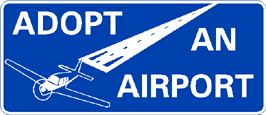 |
Mn/DOT unveiled a new
Adopt-An-Airport Program two weeks ago at the Minnesota Council of Airports
aviation symposium in Bemidji. The program is modeled on the popular Adopt-A-Highway
program that celebrated its 12th anniversary May 6.
|
Airports, like highways, need adopting and can benefit from community involvement.
That’s one of the messages underlying Mn/DOT’s new Adopt-An-Airport Program
unveiled two weeks ago at the Minnesota Council of Airports aviation symposium
in Bemidji. The announcement came less than three weeks before the 12th anniversary
on May 6 of Mn/DOT’s highly popular Adopt-A-Highway program.
Adopt-An-Airport comes to Minnesota from Pennsylvania and Virginia via its
new coordinator, aviation education specialist Janese Buzzell.
Buzzell, who merged Virginia’s Adopt-An-Airport format with Minnesota’s Adopt-A-Highway
format, said she was intrigued by the win-win solutions that matched community
service group volunteers with budget-stretching tasks that serve a public function.
Like the Adopt-a-Highway program, Adopt-An-Airport also involves local civic
and service groups picking up debris alongside roads and fences on publicly
owned property (state highway roadsides and public airport property owned and
operated by cities and counties).
The Adopt-An-Airport program, however, involves more activities and has the
potential to provide volunteers with learning opportunities and making closer
communities, according to Dan McDowell, Aeronautics public affairs coordinator.
The program can provide a cost-effective way for community groups and individuals
to support and get involved with their local airports while helping the airports
with upkeep and beautification, McDowell said.
"Several groups can adopt any one public-use airport and contribute in
different ways at the same time," he added. "Activities such as mowing,
trimming hedges, painting buildings and so on are all popular with different
civic groups. Local garden clubs have the chance to plant flowers and shrubs,
book clubs can donate reading materials and so on. Airport managers and volunteers
will develop and agree upon activities based on the expertise of the group or
individual."
"We encourage community groups to come up with ideas," Buzzell said,
adding that airport managers, however, have the final say. She cited one airport
manager at the aviation symposium who told her, "You know, this is just
great because I wanted to put together a history display of the airport. They
could help me do the research at the library, look up photos, and put together
a display."
McDowell said the program offers volunteers the satisfaction of contributing
to their community and state while generating publicity for their group.
"The interaction among groups can be a very positive and mutually beneficial
experience," McDowell said, "especially if they volunteer at the same
time or coordinate their efforts with each other."
"In many cases," added Buzzell, "the people who’d volunteer
might never have a need or a reason to go out to their local airport, and this
is a great excuse—and opportunity—to meet people involved in aviation. Many
World War II veterans, for example, work out there. What a great opportunity
for a Boy Scout troop or similar group to go out there to help out, meet the
veterans, and hear their stories."
The Office of Aeronautics can also benefit—and provide benefits—by placing
literature about aviation education programs to supplement the informal education
that volunteers could receive while helping out, Buzzell said.
There are two more groups that benefit from spruced-up airports—tourists and
businesses that depend on tourism.
Any public-use airport in Minnesota may participate in the Adopt-An-Airport
Program, which is open to civic clubs, Chambers of Commerce, business and professional
organizations, and other community groups and individuals.
Mn/DOT asks that groups and individuals adopt an airport for two years and
conduct activities at least four times a year. For more information, contact
Buzzell at 651/297-7652.
Click here for more information about Adopt-an-Airport
and Adopt-a-Highway.
|
back

|
 |
B-BOP your way to work May 16
|
 |
 |
 |
Biking is one of the
preferred modes of travel being promoted as part of the annual
B-BOP (bike, bus or carpool) day, scheduled for May 16 this
year. This bicyclist is crossing the Stone Arch Bridge heading
for downtown Minneapolis. Photo by Michelle Natrop
|
Moving Minnesota by pedal power is one of the transportation alternatives for
May 16, the 11th annual B-BOP Day, when employees are encouraged to bike, bus
or pool to work. Minnesota has more paved bicycle trails than any other state,
and B-BOP Day creates an opportunity to try those trails!
Rochester, Minneapolis, St. Paul, Mankato and Le Sueur have scheduled special
events for May 16 to honor those willing to give bicycling a try.
In Minneapolis, three different rides are planned: the south Minneapolis lakes,
Cedar Lake Trail and along the Mississippi River. All rides end between 7th
and 8th streets near the Nicollet Mall, site of a commuter information fair.
In St. Paul, five bike rides celebrate B-BOP Day: Summit Avenue, Como Avenue,
West St. Paul, Vento Trail and Battle Creek Route. St. Paul B-BOP rides end
at Mears Park, in Lowertown.
Rochester District's B-BOP activities bring together the city, the Mayo Clinic
and IBM to demonstrate how easy it is to commute by bicycle. The Rochester rides
culminate at three different areas of town: downtown, northwestern Rochester
businesses, and on the eastern end of town. To learn more about the time and
place to meet, register at http://b-bop.netfirms.com/bikeform.html.
Mn/DOT's District 7 also supports B-BOP Day by offering a healthy breakfast
for Mankato employees who B-BOP to work on May 16.
In Le Sueur, B-BOP Day brings free round trip rides on Le Sueur Transit to
those who pre-register. All Le Sueur city officials will B-BOP on May 16 and
ADC Telecommunications workers are eligible for a bus buddy pass, as well their
own free bus pass.
People working near the Capitol Complex can participate in the B-BOP Walk Around
the Capitol Office competition. The office with the most people walking will
win B-BOP day T-shirts and a B-BOP Sock Award plaque. All participants will
receive prizes. Registration materials for the walk competition are located
in the Transportation Building cafeteria, the wellness room and outside the
locker rooms.
For more information on B-BOP go to http://www.b-bop.org
or Mn/DOT's Web site at http://www.dot.state.mn.us/bike.html
.
By Gail Gendler
|
back

|
 |
Duluth co-workers, friends, family gather to honor the late Unzen
|
 |
 |
 |
Mike Robinson, District
1 transportation engineer, gave tribute to Dick Unzen, a transportation
generalist in Duluth, who was killed April 22 when he stopped his truck
on the I-535 John Blatnik Bridge to remove a ladder from the roadway.
Unzen's former snowplow truck is in the background. Photo by Maureen
Talarico
|
With his former snowplow truck in the background, Duluth District employees
honored the late Richard (Dick) Unzen on May 7, by presenting his family with
the District Engineer’s Award to honor his memory and recognize his final heroic
act.
Unzen died on April 22 when he stopped his truck on the I-535 John Blatnik
Bridge to remove a ladder that fell from another truck, blocking two lanes of
traffic. Unzen was off duty that afternoon, having just completed an early morning
snowplowing shift.
Unzen was struck and killed while he attempted to move the ladder.
A snowplow led the funeral procession when he was buried on April 25.
Unzen is the third person to earn the district’s highest award. Previous recipients
include U.S. Rep. James Oberstar for his support of the state’s and the nation’s
transportation systems and Chris Cheney, a transportation generalist at Togo
whose alert action last winter helped save a woman’s life.
Mike Robinson, the district engineer, presented the award to Gloria Unzen,
Dick Unzen’s widow, and other family members. The family also received an artist’s
print of an eagle and a letter from Rep. Oberstar lauding Unzen’s dedication
to his job and those he served.
"Dick Unzen was a man we all respected. He was the kind of person you would
like for a neighbor. He was a hard-working man who was gentle and kind, and
totally dedicated to his family, " Robinson said.
"We need to honor Dick by using this occasion to recommit ourselves to
paying attention to the hazards ahead in work zones. While Dick may not have
been officially on duty, he was doing what he professionally did—he worked to
provide for the safety of others," he added.
More than 150 employees, family members and friends attended the award ceremony
at the district headquarters where Unzen worked.
"The event was a sad but also a fitting and moving tribute to show his
family how much we cared about him," said Maureen Talarico, district public
affairs coordinator.
Peter Benner, executive director of AFSCME Council 6 also eulogized Unzen during
Worker Memorial Day ceremonies last week in Minneapolis.
Unzen, Benner said, could have called 9-1-1 to call a Mn/DOT crew to remove
the hazard, "but he thought it was his job to make sure that right of way
was safe for passing motorists."
Click here to read the earlier
Mn/DOT Newsline article about Unzen.
By Craig Wilkins
|
back

|
 |
Recycling roofs into roads: Mn/DOT, partners receive award for research project
|
 |
 |
Roofs and roads don’t have much in common other than exposure to the weather
and the sky, but thanks to one of Mn/DOT’s award-winning public-private partnerships,
roofing shingles mixed with asphalt now cover some Minnesota trails, roads and
parking lots.
Last month, Mn/DOT and its partners won the 2002 Center for Transportation
Studies Research Partnership Award for this unique partnership. The CTS award
goes to projects with measurable implementation benefits that involve University
of Minnesota researchers and both the public and private sectors.
Karen Billiar, James Klessig and Micky Ruiz, Office of Research Services, and
Roger Olson, Office of Materials and Road Research, received the award April
19 at CTS’ annual meeting. The implementation, which was several years in the
making, mixes sand with scraps created during shingle manufacturing to create
an asphalt mixture.
"Research takes a long time and implementation can take even longer,"
Ruiz commented. "But substantial benefits can be realized from large, collaborative
projects like this. This project was about letting the left brain and the right
brain work together to find a new way and a good result."
The environmentally friendly project also involved many public and private
partners, including:
-
The Minnesota Office of Environmental Assistance, which provided funds
to Bituminous Roadways in Inver Grove Heights, so it could develop special
processing equipment to grind the shingle waste and mix it with sand.
Benefits on many fronts
But where the "rubber meets the road" is the performance of the road
surface itself. Recycled shingle material looks promising here as well. Field
tests have shown comparable and even enhanced performance with the use of manufactured
asphalt shingle scrap.
Recycled shingle-asphalt mix has been used on these projects:
So far, the implementation has only used scraps created in shingle manufacturing.
In the next stage, the partnership will use a $125,000 grant from the University
of New Hampshire to look into using tear-off shingle scrap.
Recycling tear-off shingles could reap substantial environmental and economic
benefits. In the Twin Cities metro area alone, about 400,000 to 500,000 tons
of tear-off shingle scrap go into landfills each year. Using recycled shingle
asphalt can reduce the percentage of virgin asphalt needed in the mix, thus
reducing overall cost.
This second stage will be more challenging. "Consistency and durability
are key concerns here," said Klessig. "Post-consumer-waste shingles
vary in composition, deterioration and age." Recycled shingles could contain
nails, asbestos or other debris and contaminants, which complicate the recycling
process and increase costs.
By Merry Rendahl and Marsha Storck
|
back

|
 |
Lari invokes welcome to start Asian Pacific Month celebration
|
 |
 |
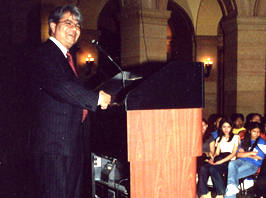 |
Adeel Lari, director
of Research Services, welcomes participants at festivities marking the
start of Asian Pacific Month in Minnesota. Lari serves as chair of the
Council on Asian Pacific Minnesotans. Photo by Craig Wilkins
|
Greeting a colorful gathering of people in ethnic dress, youthful dancers and
musicians, Adeel Lari, Research Services director, recently opened the celebration
of Asian Pacific Islander month at the Capitol.
Lari welcomed participants and visitors, introduced State Sen. Mee Moua, Minnesota’s
first Hmong legislator, and read a proclamation from Gov. Jesse Ventura honoring
the month-long event.
Lari, a native of Pakistan, chairs the Council on Asian Pacific Minnesotans.
Asian Pacific Month honors the many contributions in Minnesota made by past
and recent immigrants from Asia.
|
back

|
 |
New climate database assists roadway design
|
 |
 |
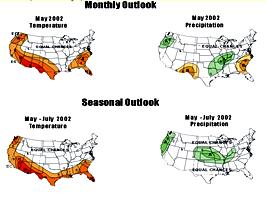 |
The new climate database
allows Mn/DOT planners, managers and designers to learn the snow and wind
history of any specific location. This is usefull in helping to pinpoint
which snow control methods and road designs work best.
|
Snow drifting onto freshly plowed Minnesota highways is no longer a "given,"
and designing drift-free roads will not require a major climate change—just
knowledge.
Thanks to a new climate database of weather data, Mn/DOT planners, managers
and designers can now learn the snow and wind history of any specific location
to help pinpoint which snow control methods and road designs work best.
"With the more precise information now available on the climatological
history of a location, we can do even more now to design drift-free roads that
will save lives, money and time," said Dan Gullickson, Mn/DOT forester
and project chair.
"This database will help in the deployment of snow fences for snow control
and/or modifying the road ditch width, depth and backslope to achieve a drift-free
road," added Dr. Mark Seeley, University of Minnesota. "We researched
snowfall and snowdrift amounts in Minnesota dating back, in some cases, to the
1850s to gain a better understanding of Minnesota’s winter weather."
Along with the database itself come classes in how to use it. This spring,
Mn/DOT staff are studying snowfall statistics, wind analysis and road cross-sections
along with the snow accumulation season and whether snow fences are needed to
attain drift-free roadways.
Mn/DOT and the university worked together for two years to create
this new database, which is posted on the University of Minnesota
Extension Service Web site. Click here to view the database: http://www.climate.umn.edu.
By Gail Gendler
|
back

|
|
 |
|



